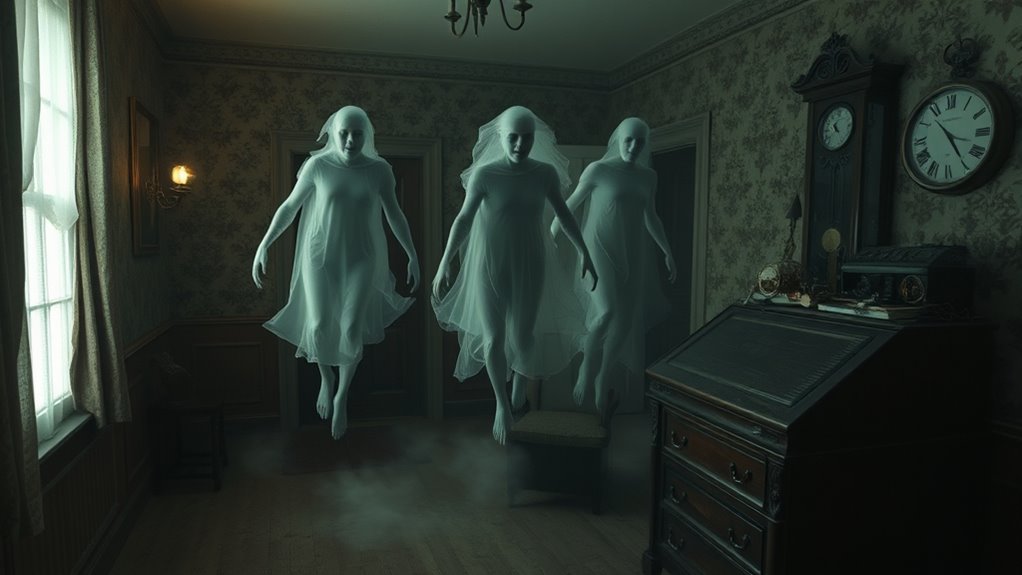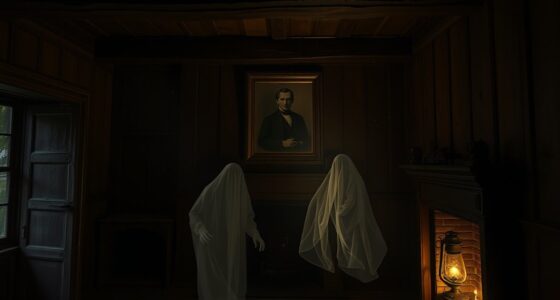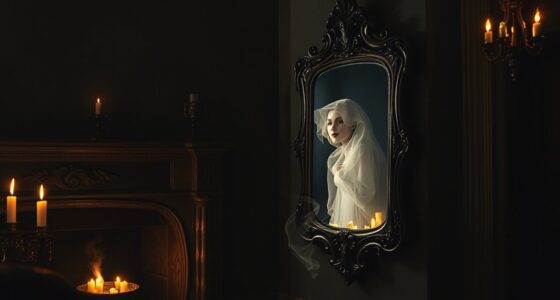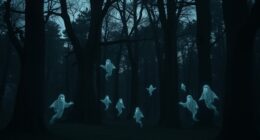The Rosenheim Poltergeist occurred in 1967 at a Munich law firm, where objects moved on their own, lights flickered, and furniture shifted, confusing staff and investigators. Despite attempts to record the phenomena, no physical cause was found, leading many to believe psychological factors like mass hysteria played a role. Media coverage amplified the activity, making it a classic case of psychological and environmental influences driving perceived supernatural events. To uncover more about this intriguing case, keep going.
Key Takeaways
- The Rosenheim Poltergeist case occurred in 1967 at a Munich law firm, involving objects moving independently and mysterious noises.
- Investigations used cameras and microphones but failed to identify a physical cause, leading to skepticism and media attention.
- Psychological explanations, such as mass hysteria and subconscious suggestion, are considered plausible causes for the phenomena.
- Environmental and social factors, including group dynamics and stress, likely contributed to the perceived paranormal activity.
- The case remains unresolved, highlighting challenges in distinguishing genuine supernatural events from psychological and environmental influences.
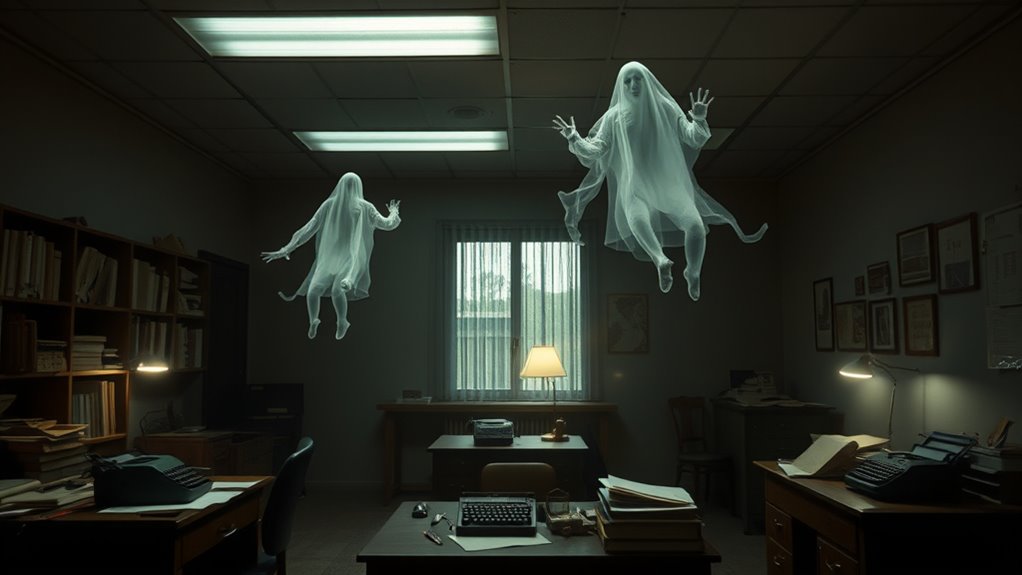
The Rosenheim Poltergeist case stands out as one of the most intriguing examples of unexplained phenomena in recent history. In 1967, a Munich-based law firm experienced a series of strange events that baffled investigators and skeptics alike. These phenomena involved objects moving on their own, mysterious noises, and furniture shifting without any clear explanation. As you explore this case, you’ll see how it became a focal point for paranormal investigations, sparking debates about whether these events were supernatural or rooted in psychological factors. The firm’s staff, especially a young secretary named Anna, reported seeing objects levitate, lights flicker, and unexplained sounds echo through the office. This intense activity persisted over several weeks, attracting media attention and prompting investigations from both paranormal experts and psychologists.
During these investigations, paranormal researchers attempted to record and observe the phenomena, but no definitive physical cause was ever identified. They used cameras, microphones, and other equipment, yet the strange events continued unabated. Meanwhile, psychologists offered alternative explanations rooted in psychological interpretations. Some believed the phenomena could have been a form of mass hysteria or subconscious suggestion, fueled by stress, fear, or an environment ripe for hallucinations. Others speculated that the power of collective belief or psychological projection might have created the illusions of objects moving and noises. The tension in the office atmosphere, combined with the intense media scrutiny, may have contributed to a self-perpetuating cycle of belief and perception, making the events seem more extraordinary than they actually were. Additionally, understanding the role of emotional support can help explain how collective stress might influence perceptions of paranormal activity. Recent research in psychological phenomena further emphasizes how cognitive biases and perception can distort experiences in such cases. Moreover, recent insights from data-driven strategies suggest that environmental and psychological factors often play a significant role in such unexplained cases. Recognizing the influence of group dynamics can also shed light on how shared beliefs can amplify perceived paranormal events. Exploring the social psychology behind these phenomena can reveal how human behavior influences the interpretation of unexplained occurrences.
Despite multiple investigations, the case remained unresolved, leaving room for speculation. Skeptics argue that the entire episode was a hoax or the result of psychological manipulation, while believers maintain that an unseen force was at work. The Rosenheim case exemplifies how difficult it can be to distinguish between genuine paranormal activity and psychological phenomena. As you analyze the case, you’ll notice the importance of considering both perspectives—scientific and supernatural—in understanding such events. This case continues to serve as a compelling example of how human perception, environmental factors, and the unknown intertwine. Whether you see it as a paranormal manifestation or a psychological construct, the Rosenheim case challenges you to think critically about the nature of unexplained phenomena and the limits of current understanding. It reminds us that, sometimes, the most convincing mysteries are the ones that make us question what we believe is possible.
Frequently Asked Questions
What Was the Long-Term Impact on the Rosenheim Community?
You might notice that the Rosenheim community experienced significant long-term impacts, including strengthened community resilience as residents came together to confront fear and uncertainty. The event also sparked cultural shifts, encouraging open discussions about supernatural phenomena and mental health. Over time, these changes fostered a sense of unity and understanding, making the community more resilient and adaptable to future challenges, ultimately shaping its social fabric in profound ways.
Were Any Scientific Investigations Conclusively Able to Explain the Phenomenon?
You might wonder if scientific investigations have conclusively explained such phenomena. Scientific skepticism plays a key role, as experts often seek physical evidence or psychological explanations. In many cases like this, investigations tend to find no definitive proof of supernatural activity, instead suggesting psychological explanations or environmental factors. So, while some phenomena remain unresolved, no scientific investigation has conclusively explained these events, leaving room for ongoing debate.
Did Any Witnesses Recant or Change Their Testimonies Over Time?
You might wonder if witnesses recanted or changed their testimonies over time. In this case, witness credibility and testimony consistency are vital. Some witnesses did modify their accounts, raising questions about reliability. However, others maintained consistent stories, strengthening overall credibility. These variations highlight how personal perceptions and memory can influence testimonies, but the case’s overall credibility remains debated due to conflicting witness statements over the years.
How Did the Case Influence Local Beliefs and Culture?
It’s ironic how a haunting can strengthen local beliefs and cultural resilience rather than diminish them. You see, the Rosenheim case deeply influenced the community’s supernatural folklore, reinforcing their conviction in unseen forces. This event, rather than scaring people away, became a part of their cultural identity, showing how extraordinary experiences can forge stronger traditions and shared stories, weaving the supernatural into the very fabric of local life.
Are Similar Poltergeist Cases Documented Elsewhere in History?
You’ll find that historical parallels to poltergeist cases are documented worldwide, showcasing similar phenomena across different cultures. These incidents often become cultural manifestations, reflecting local beliefs and fears. For instance, legends of spirit activity or hauntings appear in many societies, highlighting universal themes of unseen forces. Such cases influence local traditions and stories, emphasizing how these mysterious events resonate deeply within various communities’ histories and cultural identities.
Conclusion
As you reflect on the Rosenheim Poltergeist, you realize it’s like a whisper in the shadows—faint yet persistent, stirring the quiet corners of your mind. Sometimes, unseen forces dance just beyond your grasp, leaving behind a delicate glow of mystery. Though the truth remains softly veiled, you sense that within these gentle ripples of the unknown, there’s a story waiting to be softly uncovered, inviting your curiosity to linger a little longer in the twilight.
